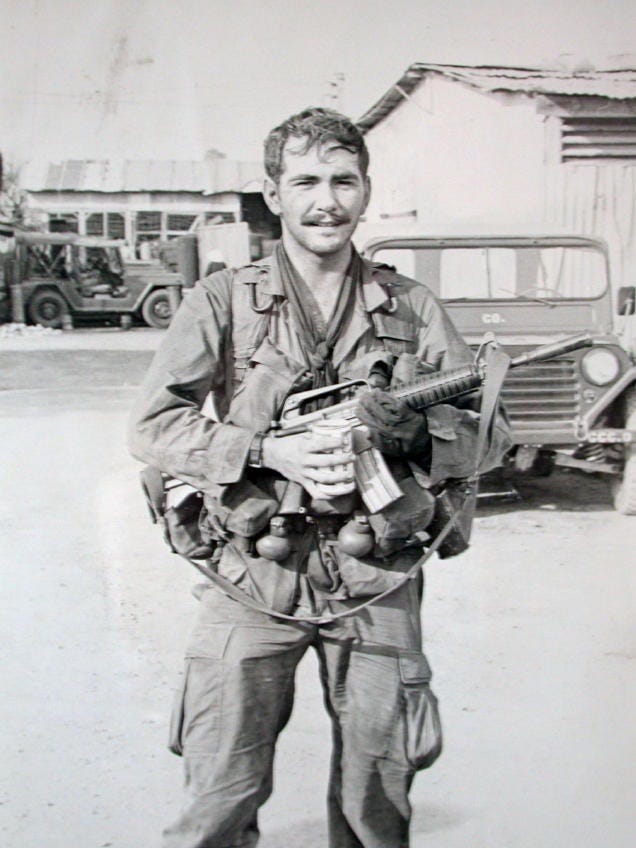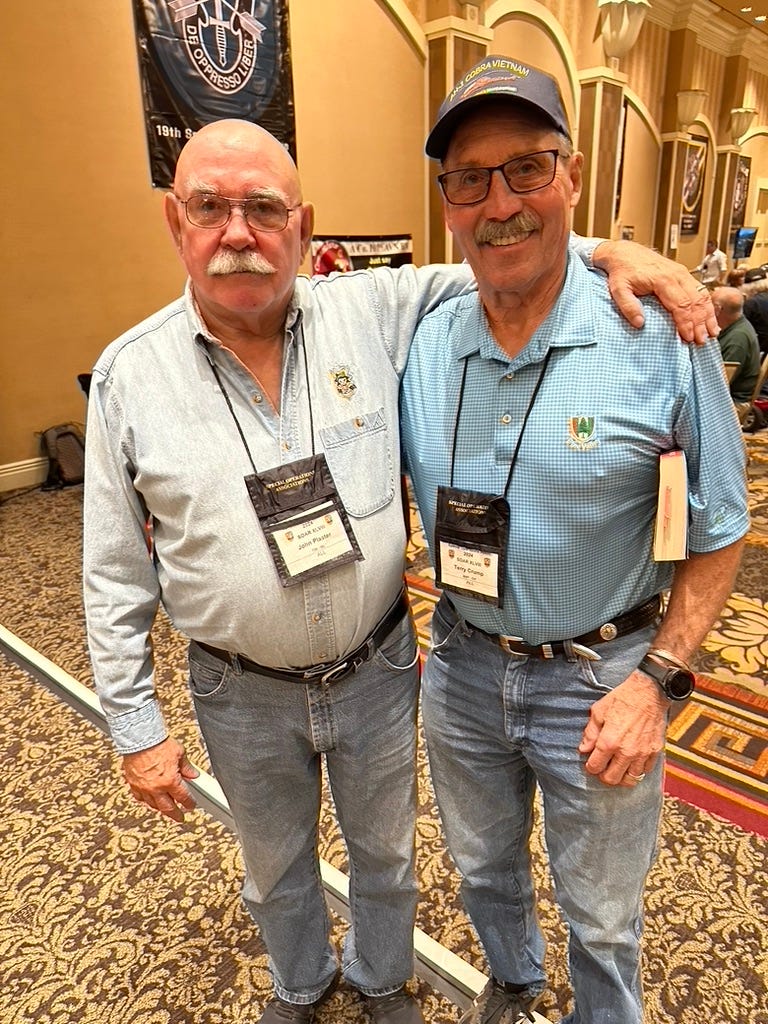High Praise for Terry and fellow Panthers from Green Beret and SOG Legend John Plaster
John “Plasticman” Plaster, one of SOG’s most famous leaders, revealed SOG’s secret war to the world in three great books. Read what he has to say about Terry and the Panthers!
(John Plaster as a SOG One-Zero)
When I went with Terry Crump to the Special Forces reunion in Las Vegas in October 2024, my biggest goal was to meet some of the incredible men of SOG and perhaps even get their help in promoting Terry’s book It Was My Turn. There was no target on my list bigger than John Plaster. Plaster’s book SOG: The Secret Wars of America’s Commandos in Vietnam was my introduction to SOG. His next book was a more personal account called Secret Commandos: Behind Enemy Lines with the Elite Warriors of SOG. His last book was SOG: A Photo History of the Secret Wars. I was reading this book when I saw a picture of Terry and Major Goins standing alongside their nearly destroyed Cobra. In that book the two were not identified, but Terry had just shown me that same photo in his collection the day before.
I walked into the main meeting room for the Special Forces reunion and John Plaster was right there! I couldn’t believe it. I couldn’t have been more thrilled if I ran into Sylvester Stallone or Travis Kelce. I’m a bit shy (yes, I am) but I walked right up to him, introduced myself, told him I had written a book about a Pink Panther pilot with seven DFCs, and that I referenced him and his books multiple times in my book, was that OK? He said, “Sure, use whatever you want.” Then I said, “Would you consider writing a foreword for the book?” He said, “Sure.” I handed him the very rough manuscript I had with me. The one, you might remember, before I took Barry Pencek’s excellent advice and cut out 40 pages. One of the stories that didn’t make the cut was one of my favorites. Called Ashtray II, Plaster led his SOG team to capture NVA prisoners alive for interrogation –– a mission called a “snatch”. It was a most amazing and thrilling story including how carefully they planned and mapped it all out, then ambushed this truck, killed one of the NVA and successfully took the prisoner. Shortly after the successful mission, Plaster was flow to Saigon and found himself explaining the whole thing to an appreciative commander of all US forces, General Creighton Abrams.
Experienced One-Zeroes, SOG reconnaissance team leaders were assigned as Covey Riders, observers in the small observation Forward Air Controller planes, flying above a SOG team. Their job was to observe the team, enemy movements, call in air assets such as the Panthers, and help coordinate communications between the guys on the ground and those in the choppers, jets or Skyraiders trying to save their lives. Plaster was Covey Rider on the now very famous Dual Prairie Fire mission in which two teams, with several friends of Plaster, were both fighting for their lives. Terry was wingman to Cobra lead Watkins on that intense mission. The mission’s communications were recorded and well over a million have listened to it on any number of websites where it can be found. Here is the one put together by Sam Erikson and Don Haase working with Savage Game Design:
If you listen to it, you will hear the calm professional voice of Plasticman identified as Delta Papa Three.
If you understand what role Plaster played with SOG in Vietnam and perhaps the even greater role of historian and explainer of SOG to the world since 1995, you will better understand how very excited I am to share with you John Plaster’s Foreword to the next edition of It Was My Turn. You will also understand just how meaningful the words of appreciation are for Terry and all the Panthers who flew in support of SOG.
FOREWORD TO IT WAS MY TURN BY JOHN “PLASTICMAN” PLASTER
A half-century ago a top secret war was fought in Southeast Asia.
It was not in South Vietnam.
This secret war was fought deep behind enemy lines in “neutral” Laos and Cambodia, against the Ho Chi Minh Trail – a term all but forgotten today. This wasn’t actually a trail but a 2500-mile road network, the logistical lifeline for North Vietnamese troops fighting in South Vietnam. Defending, operating and maintaining that heavily camouflaged highway system were tens of thousands of North Vietnamese soldiers. These numbers doubled or tripled when enemy forces, between battles in South Vietnam, withdrew to the safety of “neutral” territory. American forces were forbidden to operate in Laos or Cambodia.
The sole exception to this policy was the innocuously named Military Assistance Command Vietnam –Studies and Observations Group, (MACV-SOG), which supposedly studied the war to glean lessons learned. In reality, SOG was the war’s top secret covert operations unit, responsible for theater-wide deniable missions, especially penetrating the Ho Chi Minh Trail. Executing these cross-border missions were U.S. Army Special Forces volunteers, who led recon teams of two or three Americans and a handful of indigenous soldiers or larger formations called, “Hatchet Forces.”
Appreciate the deadly challenge faced by our Green Berets. Hidden beneath triple-canopy jungle was everything required for a modern army -- engineer units with dozens of bulldozers, 10,000 trucks, regiments of artillery, armor and infantry, depots containing food, fuel, equipment and ammunition, and the multiple headquarters that commanded it all.
I was one of those Green Berets, a SOG Recon team leader.
Our mission was to infiltrate these dangerous lairs to gather intelligence and do to the North Vietnamese what they were doing to our fellow Americans in South Vietnam. We reconned and raided, directed air strikes, mined roads, tapped commo lines, assessed B-52 strikes, planted sensors, searched for American MIAs, sabotaged enemy ordnance, even ambushed truck convoys. Understandably, these were extremely hazardous missions. Not only were there 60,000 North Vietnamese soldiers stationed in Laos, but special units of trackers and counter-recon units were organized solely to hunt us down and kill us. Casualties among our SOG recon Green Berets sometimes grew universal – at times exceeding 100% -- because each recon American had been wounded, killed or went missing and their replacements, too.
Our SOG soldiers could not possibly have accomplished – or survived – these missions without Chief Warrant Officer Terry Crump, the subject of this book, and his fellow aviators. Operating beyond the range of American artillery in South Vietnam, we were entirely dependent upon air assets for insertion, extraction and fire support.
In that hostile environment, enemy ground fire was an everyday hazard much beyond that faced by helicopters flying over South Vietnam. The Laotian panhandle contained the world’s heaviest anti- aircraft concentration, an estimated 10,000 guns turned skyward, hoping the likes of Terry’s Cobra would pass by.
These heavy anti-aircraft weapons included twin-barreled 23mm automatic cannons and 37mm truck-towed guns.
At least weekly one of our teams was in a fight-for-their-lives, pursued and outnumbered by North Vietnamese soldiers. In these life-and-death encounters, when it seemed all was lost, I cannot communicate how just the sound of those approaching Cobras gave us heart. Thanks to Terry and his fellow Pink Panthers, situations sometimes thought “impossible” were not. But they might have been if not for airmen like Terry and his helicopter comrades.
This took courage, flying skill and accurate shooting. Understand, Terry could not have delivered ordnance “danger-close” without flying “danger-close.” Yet he and his fellow Panthers precisely delivered that ordnance despite enemy ground fire -- so close that their mini-gun expended brass once showered across my team, with one hot cartridge going down my jungle shirt. Dangerous? Yes. But those were desperate situations.
At times the situation became especially desperate. In these pages you will read about the events of 29 January 1971, when two SOG recon teams simultaneously were in such heavy contact that they might have been overrun. I was there that day, along with Terry and his Pink Panther gunships and a half-dozen “Bikini” White Flight Hueys. I was overhead, aboard a Forward Air Control Aircraft flown by USAF Captain Mike Cryer. Remarkably, this entire incident was recorded by one of the pilots and can be heard online at Youtube. [link provided above]
Recon Team Hawaii was doing its best to hold a landing zone long enough for a Huey to come in and extract them. Terry and the gunships peppered the area with rockets, miniguns and 40mm fire and escorted a Huey into the LZ. Several times enemy fire erupted, forced it away, bringing the Cobras in to suppress enemy fire. This was about five kilometers north of Highway 110.
Then a radio voice declared another team in danger of being overrun, Recon Team Colorado, roughly ten kilometers south of the road. Already, one of the team’s Green Berets was dead and another badly wounded. The Special Forces team leader needed fire support.
Should you listen to the audio, you will hear the understandably stressed voices of both teams, on the verge of being overrun. And then you’ll hear the lead Huey pilot’s voice, unemotional, professional, as calm as can be: “White Lead, Taking fire, three O’clock.”
“Roger, [this is] Panther Three-Eight. I’m on it.” Panther Three-Eight was, in fact, Terry Crump.
After a tense half-hour of repeated Cobra gun-runs and ground fire at the Hueys, Recon Team Hawaii was extracted without a single casualty. Afterward, we were able to extract RT Colorado, too, with no further casualties than those initially suffered.
Two close-run extractions in perhaps one hour. And everyone coming home. This overwhelmed the 170 th Aviation Company Huey crews, who’d dodged enemy fire again and again while Terry and the Cobras fired in their support.
Referencing that gunship support, White Lead radioed, “I think I’ll buy them a drink….”
Another Huey pilot added, “I think [you’re] gonna have to kiss ‘em and give ‘em a beer.”
A third pilot radioed, “These guys are fantastic! Fantastic!”
Yes, I agree.
Beyond his awards and decorations, Terry Crump’s ultimate achievement was not the medals ---though he deserved every one of his seven Distinguished Flying Crosses. But that good men and their grandkids are alive today because Terry and his fellow Pink Panthers were there when we most needed them.
Thank you Terry, from me and all the Green Berets whose lives you saved. We’re good for a beer whenever we meet.
JOHN PLASTER
“The Plasticman”
Below: Terry Crump and “Plasticman” John Plaster at the 2024 SOAR reunion.





